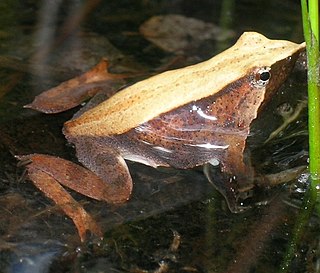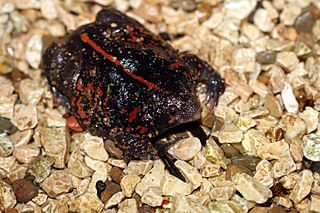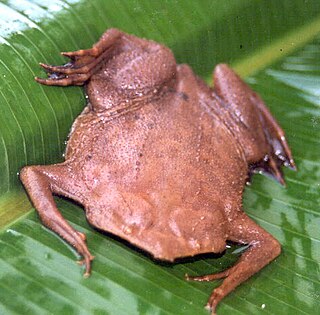
Amphibians are ectothermic, anamniotic, four-limbed vertebrate animals that constitute the class Amphibia. In its broad sense, it is paraphyletic group encompassing all tetrapods excluding the amniotes. All extant (living) amphibians belong to the monophyletic subclass Lissamphibia, with three living orders: Anura (frogs), Urodela (salamanders), and Gymnophiona (caecilians). Evolved to be mostly semiaquatic, amphibians have adapted to inhabit a wide variety of habitats, with most species living in freshwater, wetland or terrestrial ecosystems. Their life cycle typically starts out as aquatic larvae with gills known as tadpoles, but some species have developed behavioural adaptations to bypass this.

A frog is any member of a diverse and largely carnivorous group of short-bodied, tailless amphibians composing the order Anura. The oldest fossil "proto-frog" Triadobatrachus is known from the Early Triassic of Madagascar, but molecular clock dating suggests their split from other amphibians may extend further back to the Permian, 265 million years ago. Frogs are widely distributed, ranging from the tropics to subarctic regions, but the greatest concentration of species diversity is in tropical rainforest. Frogs account for around 88% of extant amphibian species. They are also one of the five most diverse vertebrate orders. Warty frog species tend to be called toads, but the distinction between frogs and toads is informal, not from taxonomy or evolutionary history.

The larynx, commonly called the voice box, is an organ in the top of the neck involved in breathing, producing sound and protecting the trachea against food aspiration. The opening of larynx into pharynx known as the laryngeal inlet is about 4–5 centimeters in diameter. The larynx houses the vocal cords, and manipulates pitch and volume, which is essential for phonation. It is situated just below where the tract of the pharynx splits into the trachea and the esophagus. The word 'larynx' comes from the Ancient Greek word lárunx ʻlarynx, gullet, throat.ʼ

A tadpole is the larval stage in the biological life cycle of an amphibian. Most tadpoles are fully aquatic, though some species of amphibians have tadpoles that are terrestrial. Tadpoles have some fish-like features that may not be found in adult amphibians such as a lateral line, gills and swimming tails. As they undergo metamorphosis, they start to develop functional lungs for breathing air, and the diet of tadpoles changes drastically.

The goliath frog, otherwise known commonly as the giant slippery frog and the goliath bullfrog, is a species of frog in the family Conrauidae. The goliath frog is the largest living frog. Specimens can grow up to 32 centimetres (12.6 in) in length from snout to vent, and weigh up to 3.25 kilograms (7.2 lb). This species has a relatively small habitat range in Cameroon and Equatorial Guinea. Its numbers are dwindling due to habitat destruction, collection for food, and the pet trade.

Darwin’s frog, also called the Southern Darwin's frog, is a species of Chilean/Argentinian frog of the family Rhinodermatidae. It was discovered by Charles Darwin during his voyage on HMS Beagle. on a trip to Chile. In 1841, French zoologist André Marie Constant Duméril and his assistant Gabriel Bibron described and named Darwin's frog. The diet of R. darwinii consists mostly of herbivore invertebrates. R. darwinii is currently classified as an endangered species by the International Union for Conservation of Nature.

Rhinoderma, commonly known as Darwin's frogs, is a genus of small frogs found in Chile and adjacent parts of Argentina. It has just two species, of which the Chile Darwin's frog is highly endangered or may already be extinct. The better-known Darwin's frog is endangered.

The Mexican burrowing toad is the single living representative of the family Rhinophrynidae. It is a unique species in its taxonomy and morphology, with special adaptations to assist them in digging burrows where they spend most of their time. These adaptations include a small pointed snout and face, keratinized structures and a lack of webbing on front limbs, and specialized tongue morphology to assist in feeding on ants and termites underground. The body is nearly equal in width and length. It is a dark brown to black color with a red-orange stripe on its back along with splotches of color on its body. The generic name Rhinophrynus means 'nose-toad', from rhino- (ῥῑνο-), the combining form of the Ancient Greek rhis and phrunē.

The pickerel frog is a small North American frog, characterized by the appearance of seemingly "hand-drawn" squares on its dorsal surface. Pickerel frogs are the only poisonous frog native to the United States.

Gastrophryne carolinensis, the eastern narrow-mouthed toad, is a species of microhylid frog. It is a relatively small, toad-like amphibian found in damp, shady habitats. The species is highly fossorial, and feeds primarily on ants. These North American microhylids are distinguished from true toads, and other anurans by their moist, smooth skin, their lack of eardrums or tympana, their distinguishable squat body shape, and the unique fold of skin superior to their eyes. It is found in the United States, from southern Maryland to the Florida Keys, west to Missouri and Texas. While not a true toad, it is so called because it is terrestrial.

Uperodon variegatus, also known as the Eluru dot frog, termite nest frog, variable ramanella, variagated ramanella, white-bellied pug snout frog, or variagated globular frog, is a species of narrow-mouthed frog that is endemic to India. Earlier records from Sri Lanka refer to what is now known as Uperodon rohani. They are seen mostly in the monsoon season when they may enter homes. They are small in size and the variegated markings and the genus characteristic of having pads on the fingertips but not on their toes make them easy to identify.

The mouth is the body orifice through which many animals ingest food and vocalize. The body cavity immediately behind the mouth opening, known as the oral cavity, is also the first part of the alimentary canal, which leads to the pharynx and the gullet. In tetrapod vertebrates, the mouth is bounded on the outside by the lips and cheeks — thus the oral cavity is also known as the buccal cavity — and contains the tongue on the inside. Except for some groups like birds and lissamphibians, vertebrates usually have teeth in their mouths, although some fish species have pharyngeal teeth instead of oral teeth.

Atelopus franciscus, the Central Coast stubfoot toad, is a species of toad in the family Bufonidae, endemic to the central coastal region of French Guiana. It is a locally common, diurnal species found near fast-flowing small streams and creeks in lowland rainforest. Many authors have suggested this taxon might be a synonym of Atelopus flavescens. It is threatened by habitat loss.

The Yosemite toad is a species of true toad in the family Bufonidae. Endemic to the Sierra Nevada of California, the species ranges from the Alpine County to Fresno County. Yosemite toads are only found in the montane to subalpine elevational zone of 1,950–3,445 m (6,398–11,302 ft) asl. The Yosemite toad is similar to the nearby western toad, but in many ways adapted to a high elevation lifestyle. It was initially described during the Grinnell Survey of California, by an undergraduate student of Joseph Grinnell named Charles Camp.

The oak toad is a species of toad in the family Bufonidae. It is endemic to the coastal regions of southeastern United States. It is regarded as the smallest species of toad in North America, with a length of 19 to 33 mm.

The green-eyed treefrog is a species of Australasian treefrog in the subfamily Pelodryadinae that occurs in the Wet Tropics of Australia.

The Túngara frog is a species of frog in the family Leptodactylidae. It is a small nocturnal terrestrial frog found in Mexico, Central America, and the northeastern regions of South America.

The Chile Darwin's frog, also called the northern Darwin's frog, is a possibly extinct frog, and one of only two members of the family Rhinodermatidae. It is endemic to central Chile.
Frogs and toads produce a rich variety of sounds, calls, and songs during their courtship and mating rituals. The callers, usually males, make stereotyped sounds in order to advertise their location, their mating readiness and their willingness to defend their territory; listeners respond to the calls by return calling, by approach, and by going silent. These responses have been shown to be important for species recognition, mate assessment, and localization. Beginning with the pioneering experiments of Robert Capranica in the 1930s using playback techniques with normal and synthetic calls, behavioral biologists and neurobiologists have teamed up to use frogs and toads as a model system for understanding the auditory function and evolution. It is now considered an important example of the neural basis of animal behavior, because of the simplicity of the sounds, the relative ease with which neurophysiological recordings can be made from the auditory nerve, and the reliability of localization behavior. Acoustic communication is essential for the frog's survival in both territorial defense and in localization and attraction of mates. Sounds from frogs travel through the air, through water, and through the substrate. Frogs and toads largely ignore sounds that are not conspecific calls or those of predators, with only louder noises startling the animals. Even then, unless major vibration is included, they usually do not take any action unless the source has been visually identified. The neural basis of communication and audition gives insights into the science of sound applied to human communication.

The common Surinam toad or star-fingered toad is a purely aquatic species of frog in the family Pipidae with a widespread distribution in South America. The species is known for incubating its eggs in honeycombed chambers in the skin of the mother's back, releasing fully formed froglets after a period of 4–5 months. It is an ambush predator that lies in wait in the water for prey to come into range, which it then captures using suction feeding.























